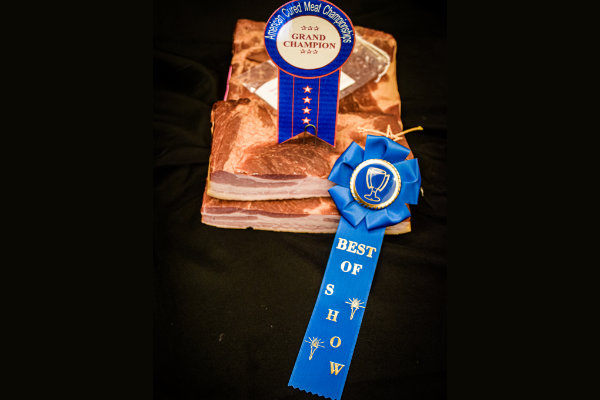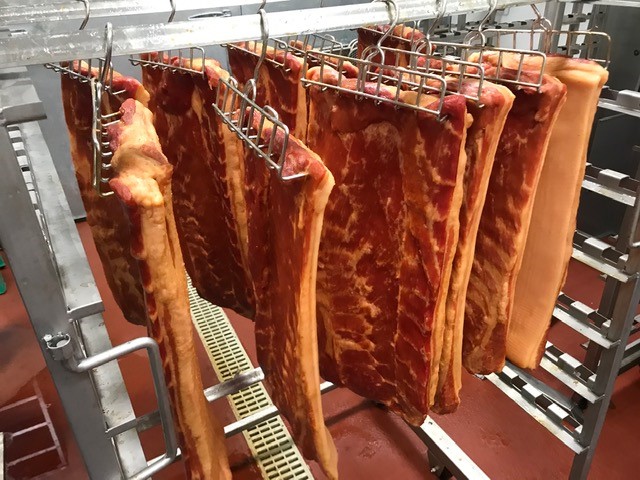In 1949, some small meat processors got together in Chicago, and entered hams they made in competition in the First Annual National Ham Show. Sixty-five hams were submitted and were judged in four classes.
That small competition began what is known today as the American Cured Meat Championships (ACMC). It is the largest meat competition in North America, and it is the only event of its kind on the North American continent.
The event grew over the years into a variety of cured products that include bacon, sausages, frankfurters and wieners, smoked turkey, ring bologna, jerky and snack sticks, and ham, as well as others. At the most recent Cured Meats competition in 2022, which is always part of the American Association of Meat Processors (AAMP) annual convention, there were 623 products entered in 29 classes of meat products. More than 45 volunteers, AAMP staff members and ACMC coordinators and judges gave almost 300 hours to select the winners.
Culitvating Competition
The bacon winners at the American Cured Meat Championships in 2022 were: Bardine’s Country Smokehouse, Crabtree, Pa., not far from Pittsburgh, winning the blue ribbon and grand championship for heavyweight bacon and Tulare Meat Locker & Sausage Co., Tulare, Calif., in the San Joaquin Valley, who won the blue ribbon and grand championship for lightweight bacon.
Dewig Meats, in Haubstadt, Ind., not far from Evansville in southern Indiana, won the blue ribbon and grand championship for country bacon – dry cured. In addition to being longtime active members and leaders in AAMP, Dewig Meats also is a member of the Indiana Meat Packers and Processors Association.
Bardine’s also won the Clarence Knebel Best of Show Award. Dewig Meats won the Cured Meats Excellence Award, which goes to the processor with the best overall performance in the competition. Danny Mendes, owner of Tulare Meat Locker, won the Accomplishment Award, given to a member who has been in the industry for a relatively short period of time, and who has distinguished himself or herself with new products or company growth.
Like many other members of the American Association of Meat Processors, these three companies have won many awards in product competition, both at the national level at AAMP and in state meat association shows.
 Source: American Association of Meat Processors
Source: American Association of Meat Processors
Detail oriented
Gary Bardine, who also belongs to the Pennsylvania Association of Meat Processors, said his award-winning bacon in the heavyweight bacon division is his regular hickory-smoked bacon. “I make it using simple ingredients, with salt, sugar and sodium nitrite, aged and smoked with hickory wood,” he said. “I do a wet cure and it is tumbled. Then it sits before it is hung up and then smoked.”
“I’m a very detail-oriented guy. You also need good equipment, good tumbling, and good smokehouses, and of course, good product to start with,” he explained.
“The raw materials that I use are very important, like for this bacon that won. I buy my materials by the combo, my bellies come from Iowa,” he said. “I like the 11-to-12-pound bellies for my bacon.”
He used to make all the products himself, but he said it is nice for other people working at the company to help him. Bardine has a team of about 20 who work at the plant and store.
“My production manager, Cort McCurdy, cures my bacon for me now. He made products for this show. So, I’ve toned down a little now. Cort cures the bacon, jerky, and our other employees are heavily involved in what we’re doing here as well,” Bardine said.
The company is now a fourth-generation business, but it has not been a continuous operation through the generations. The business was begun by an Italian immigrant, who passed it on to his son.
"My grandfather, my father, and I had separate businesses, all in the farm and meat industry, but we all had our own places,” he said. “From 1973 to 1991, there was no business, we just had the farm. Then I started my own meat processing business, which was wholesale and retail, including inspection.”
Now he operates a strictly retail business.
“I’m 54 years old and I’ve been processing meat since I was a kid,” he says with pride.
For his winning bacon at the American Cured Meat Championships, and for meat processing in general, Bardine believes both science and art play a role.
“Science is important in meat production and curing, including nitrites. The art of meat production comes into it as well, because you want the meat to look, feel and taste perfect.”
Bardine believes it is important for small businesses in the meat and poultry industry to enter the meat competitions, like the American Cured Meat Championships, and the state association shows.
“Meat competition and winning awards help our businesses grow. People come into the store, and they see the ribbons and awards. That certainly encourages people who want excellent, top-quality meat to come here and patronize our business. There is a reason we can sell meat up on the hill in a tiny little place like Crabtree, Pennsylvania.”
 Source: Tulare Meat Locker & Sausage Co.
Source: Tulare Meat Locker & Sausage Co.
Successful Newcomer
“My bacon, which won the lightweight bacon category, which is less than nine pounds for the finished product, is an old-fashioned sugar-cured bacon, and hardwood smoked,” said Danny Mendes, owner of Tulare Meat Locker & Sausage Co. He has only been in the business for about six years, “…so I’m fairly new to AAMP. I’m also in the California Meat Processors Association. I got into smoking and curing, and I love it.”
He said for the bacon competition, “…the judges are looking for the salt and the sweet. I try to find the best bellies from Midwestern suppliers – pork producers, Seaboard and others, the Midwest slaughterhouses.”
“For this product that won, and for all our bacons, we have our own cures, and we do the tumbling process, we do not inject. We let the product sit for 24 to 48 hours,” Mendes said.
He thinks making his bacon, and other meats, for that matter, is both art and science.
“Not only for competitions like this,” he said. “But also, for the retail, which you’re selling to your customers. And for custom processing, which goes back to the animal owner. You need the product to be the perfect shape, the perfect color, the perfect taste, not just for competition and shows, but for all my products.
“We use ScottPec smokehouses for all our smoked products, including this bacon, and for our retail products. Everything we do – whether it is custom butchering, products for our retail shop, is the same quality as for a show. We’re a mom-and-pop shop, custom-exempt, state inspected, and we sell our retail product out of our place. We have six employees and 2,400 square feet. The CAMP show is next week, and we’ll be entering that, too.”
Experiencing Success
Matthew Wenger, program specialist at Iowa State University, is the American Cured Meat Championship’s coordinator. Terry Houser, PhD, associate professor and Smithfield Foods chair in meat science extension at Iowa State; Jeff Sindelar, PhD, professor and extension meat specialist in the Department of Animal Sciences at the University of Wisconsin-Madison; Jonathan Campbell, PhD, meat extension specialist and associate professor of animal science at Penn State; and Joseph Cordray, PhD, professor emeritus of animal science at Iowa State, are the technical advisors for the competition. The annual competition allows a spokesperson to introduce the brand to viewers on the national platform and develop a connection with customers.
Wenger noted that safety is a prime reason that products in the show are cured. They can be transported more easily and safely than fresh meats, and are judged in a room with a temperature of 40°F.
The judges consist of 13 academic and industry representatives, along with two professors who have been inducted into the AAMP Cured Meats Hall of Fame. In the show, there is usually a featured product class, most often regional to where the convention is being held. So, in 2022, with the convention in Iowa, the class was flavored bacon.
“Most of the judging is done individually, though a few classes are judged by pairs of judges,” he said. “Meat classes are judged on external appearance, internal appearance, texture, cutability, aroma and flavor, based on a 1,000-point system.”
Sindelar organizes the judges. He started as a judge while a graduate student at Iowa State University, while working with Cordray. “One of the great benefits of this show, and state association shows around the US is that it helps these small processing businesses to become even more successful.” Sindelar said. “It’s nice for them to achieve even greater success, thanks in part to these competitions.”
“Universities like the University of Wisconsin, Iowa State, Penn State, and many others have extensive animal and meat science programs and extensions. We work with small, medium-sized, and even large processors.
“But I think our greatest help and benefit goes to the small and very small processors, who don’t have the facilities, laboratories and training that big companies have. In that way, we are of great help to them, I think. The small meat and poultry businesses had to face great challenges during the pandemic, if they were going to not only survive but also grow and prosper. I think they are succeeding.”



